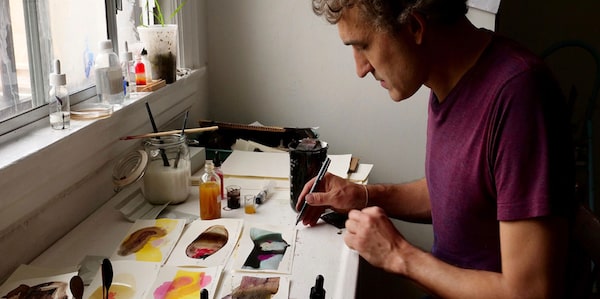
Toronto-based artist and ink-maker, Jason Logan, traces the history of ink and its impact on the world, in Brian D. Johnson’s lush and visually striking film shot by celebrated cinematographer Nicholas de Pencier.TIFF/Courtesy of TIFF
When we reach the spot in Toronto’s Cedarvale Ravine where, in spring, a runoff of iron from the city streets meets an invisible colony of bacteria, which eat iron and turn it into ochre – that’s where I see peak Jason Logan.
Logan, 50, is a Toronto-based writer, illustrator and art director for magazines and digital media. His work has appeared in this paper, The New Yorker and The New York Times. His fifth book, How to Be a Colour Wizard, is due next fall. A few years ago, he waged a campaign, “Toronto Needs a Creative Director” – Manchester, England, and Mexico City had improved their cities by appointing one – and almost convinced John Tory to do it.
But 17 years ago, Logan found his true calling: making ink, by hand, in his home; bottling it in elegant small vessels with labels he draws, which read the Toronto Ink Company; and selling it. He also sends it, free, to friends and strangers he admires, forming connections that span continents. Moreover, as the new Canadian documentary The Colour of Ink shows, in ink, Logan may have found nothing less than a better way of being on Earth. (Directed by journalist turned filmmaker Brian D. Johnson, with luscious cinematography by Nick de Pencier, it premieres at the Toronto International Film Festival Sept. 15.)
On this sunny September Tuesday, I meet Logan at the southern end of the ravine. He’s dressed for foraging in jeans, Blundstones and a soft blue jacket. A married father of three (his wife is the author Heidi Sopinka), he resembles Justin Trudeau, though his curly hair is slightly greyer; he speaks carefully and has a pleasantly giddy laugh.
There’s something otherworldly about Logan, a sense that he floats above or through things. The son of a peripatetic United Church minister, he’d lived in 12 homes by age 12, and making friends wasn’t easy: Mesmerized by nature, he was often teased for being “dazed out.” He began drawing in his second year at Queen’s University, when he was laid up with a hematoma after a football player/actor punched him in the stomach during a play they were doing about Andy Warhol. Today, Logan’s backpack holds, as it always does, a blocky sketchbook (he has “probably a thousand”) and baggies for whatever he may collect.
Immediately, we’re filthy. He leads me into a thicket of buckthorn, where we break off twigs and squeeze blue juice from the berries. When the berries are black, Logan says, their juice turns purple, and if you add lye, it turns green. Buckthorn wood was used in gunpowder, and the ink from that gunpowder, indigo running to gold, was used on medieval manuscripts.
Moving on – slowly; Logan believes in the power of slowly – we pass a stand of jewelweed, blossoms like speckled orange jelly beans. His late mother loved them – she died when he was 7, and his childhood after that was “as bad as it gets,” he says succinctly – but they’re no good for ink: “Flowers are tricky. You’re drawn to them, but usually they are the end point of their colour.”
We get tangled in wild grape vines, which, carbonized, make a silky black ink that may be the ink on the Dead Sea Scrolls. We move through shoulder-high goldenrod, which Logan would be heaping into his backpack if he didn’t already have heaps in his basement; it makes an autumn-yellow ink. We spy mushrooms but Logan sidesteps them – “I can’t take on mushroom inks, I’m afraid I’d abandon my family,” he says, only half joking.
Not everything can be ink. Logan blew up a few microwaves trying to break down shellac. Many of his mad-scientist combinations result in ink that’s just … brown. And not everyone he sends ink to responds. He spent a month putting together the perfect package for Yoko Ono – one earth ink, one sky and one water – yet she never replied.
But then we hit the unassuming spot near an overpass where the spring runoff, heavy with iron from the city’s debris, collects and intensifies in a small swampy patch, “where the colonies of microbes that eat it build cathedrals of colour that we turn into art supplies,” Logan says. “Ochre is found in only a few spots in the world” – Roussillon, France is perhaps the most famous – “and one is right here.”
He launches into a story about how chips from rock paintings in British Columbia were fed into a nuclear reactor in Hamilton, where it was determined that their red colour could only be produced at 750 degrees, which means that 1,000 years ago whoever painted them figured out that cooking scum to that heat – and no hotter, or the ochre goes black – creates a red that lasts forever.
And that’s when I get it. For Logan, ink is a living thing, connected to everything on Earth that is alive and isn’t. It has the awe of magic and the spirit/matter entwinement of alchemy and the solid evidence of history and the relentless question/experiment/result rigour of science. It’s not a metaphor for anything – it’s the materiality that matters.

Jason Logan began drawing in his second year at Queen’s University, when he was laid up with a hematoma after a football player/actor punched him in the stomach during a play they were doing about Andy Warhol.TIFF/Courtesy of TIFF
He doesn’t make an overt environmental plea, neither in the documentary nor to me; he merely says that if you look carefully, and stoop to pick up that crimson berry or bit of marble dust or railroad spike (or even that old gun), and then you mix it with other stuff, you can make something beautiful that you can bottle and mail to an artist, and that artist will make something beautiful with it that she may send back to you, and a connection will have been made, and an appreciation will have been forged: That everything on Earth is part of everything else, now and through time, so we better pay attention.
It’s possible that The Colour of Ink could make Logan into a guru of sorts. It’s a prospect he’s ambivalent about. “I don’t want to be a leader of anything,” he says. “But I do, I guess. Because it’s so legitimate and exciting, what I’ve learned about ink. I’m not saying it will save the world, but there’s something in the spirit of getting close to the ground that is what we humans are going to need.”
If he were a guru, his message would be a simple one. “At some point, close your computer, walk outside and wander for a bit, listening, watching,” he says. “I want people who feel stuck in something defined, to find a moment of freedom. It’s not, go to the Himalayas to do a selfie adventure. It’s, see a plant in a crack in the street, and feel in relation to it. Touch it, smell it. It happens at your fingertips.”
Special to The Globe and Mail
Sign up for The Globe’s arts and lifestyle newsletters for more news, columns and advice in your inbox.
 Johanna Schneller
Johanna Schneller